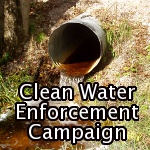In the summer of 2023, Governor Newsom signed Senate Bill 149 into law. This bill gave the Governor the power to fast-track infrastructure projects deemed beneficial to the state of California’s bid to create a climate-resilient future.
On November 6th, 2023 the Governor used this law to fast-track approval for the highly controversial Sites Reservoir Project. In a statement, the Governor characterized this move as “cutting red tape.” The red tape in question is the normal scrutiny the Sites Project would be subject to under the California Environmental Quality Act (CEQA).
Governor Newsom’s decision to fast-track the Sites Project is based on his assertion that it is beneficial to the environment. The Governor’s rhetoric is in line with the Sites Project’s public relations campaign. When the drought hits, they argue, the Reservoir will release water, in part, to ensure the survival of downstream habitat and species. This is a deceptive narrative.
The reality is that there is a high demand for water in California’s agricultural sector. The dams and diversions already in place to feed that demand are the very cause of the ecological distress of the Sacramento River and the Bay-Delta estuary it flows into.
Further, proponents of Sites have released no operations plan describing how they will use the reservoir to reduce the impacts of drought on fish and wildlife. They rely instead on repeating that they “could” do helpful things with more water in storage.
Climate change and impending species extinction are a major concern for all environmentally conscious Californians. The Governor and those in charge of Sites are using this widespread concern to push through a project that will damage fish and wildlife. This tactic is called greenwashing.
Greenwashing is a common branding tactic. Used across many industries and government agencies, greenwashing is when one frames a product or project in terms that highlight its purported benefits to the environment. This assertion is made even when the product or project is primarily for different purposes.
The Governor and the Sites Project leadership have made an assertion that the project is beneficial to the river environment, despite extensive evidence disputing this claim. Armed with a greenwashed project and SB 149, the Governor is circumventing processes put in place to protect fish and wildlife from destructive projects just like the Sites Reservoir.
CEQA is a crucial process that development projects must pass through in order to help ensure that they do not degrade California’s environment. Signed into law by Governor Reagan in 1970, CEQA aims to inform the public and decision makers on the potential environmental impact of public and private developments.
Under CEQA, Sites Reservoir Project was classified as having the potential to have significant (negative) environmental impacts. Thus, the Sites Project was then required to produce an Environmental Impact Report (EIR). The EIR for the Sites Project is thirty-four chapters long.
The Final EIR for the Sites Project was released to the public on November 2, 2023. After two additional procedural steps (expected before Thanksgiving 2023), opponents of the Sites Project, such as the California Sportfishing Protection Alliance (CSPA) and its allies, will have thirty days to make a legal challenge to the EIR for the Project in court.
SB 149 limits the amount of time the court can take to make a decision on an EIR to just 270 days. SB 149 was intended to fast-track non-controversial projects. But the Sites Project is far from non-controversial.
When inappropriately applied to a complicated, controversial, and environmentally damaging project, SB 149’s 270-day timeline places a tremendous burden on attorneys to prepare and make their cases, as well as on judges to review the law and the facts and render a decision.
The Sites Project aims to build a reservoir on two small creeks in Colusa County. But it is an off-stream reservoir, meaning that only a tiny percentage of the projected 1.5 million acre-feet of water to fill the reservoir will come from those creeks. The water to fill the reservoir will be diverted from the Sacramento River into large canals, then pumped from the canals to the reservoir. Sacramento River ecosystems are already under great duress from the impoundment and overallocation of its waters.
In January 2021, a coalition of thirteen environmental nonprofits argued against the idea that the “environmental benefits of the proposed Sites Reservoir are a foregone conclusion.” In the comments they submitted to the Project’s proponents and the Bureau of Reclamation, they said, “Project benefits remain speculative, and environmental harms of Sites have yet to be properly assessed.”
The coalition said that the Project was “underestimating potential impacts associated with Sites-induced diversions on the flow-dependent Sacramento River riparian habitat.”
The coalition went on to say that the Project ignores a “scientific consensus that Sacramento River riparian habitat is ultra-sensitive to even slight modifications in the natural flow regime. Riparian dependent species along the Sacramento River have continued to decline under the extensively modified flow regime caused by Shasta Dam operations and will likely continue to decline under even minor flow modifications caused by Sites operations.”
Fast-tracking Sites Reservoir threatens to fast-track the extinction of the already depressed populations of Chinook salmon. In a protest of the water rights application for the Sites Project, CSPA and its allies point out that “the Sites Application proposes minimal flow protection on the Sacramento River for salmon and no explicit flow protection for sturgeon.”
A different coalition led by the San Francisco Baykeeper reached the same conclusion in their protest. They said that granting the Sites Project water rights to the Sacramento River “is likely to reduce the survival and abundance of winter-run Chinook Salmon, primarily because the proposed bypass flows are inadequate to protect the species.”
In the CSPA protest, the coalition of fourteen environmental non-profits and the Winnemem Wintu tribe go on to describe in detail the damage the Sites Project may do to fish and wildlife. They state that altered flow caused by Sites Reservoir will further threaten the “western yellow billed cuckoo, Swainson’s hawk, bank swallow, and the valley elderberry longhorn beetle.” These are species already listed as threatened, endangered, or species of concern.
The Governor and those in charge of the Sites Reservoir Project want you to believe they are spending 4 billion (mostly tax) dollars on a project that will help the environment. A large coalition of non-governmental organizations and tribes strongly disagree. They argue that the Sites Project will add to the dire conditions of the Sacramento River, the Delta, and the already imperiled habitats and species within them.
The truth will not be revealed by branding exercises such as the Governor’s Declaration that the Sites project is environmentally beneficial. Review by a court is one of the major protections the public has for its treasured fish and wildlife resources. The Governor’s Declaration reduces protections by making that review that much harder.
Editor’s Note: On November 17, 2023, the Sites Project Authority certified the Final EIR for the Sites Project. In response, CSPA, Friends of the River, and the Sierra Club issued a press release.









